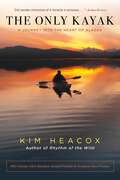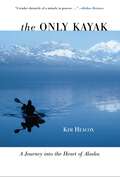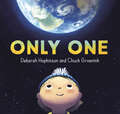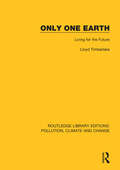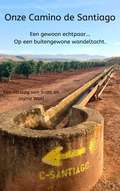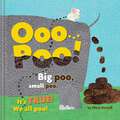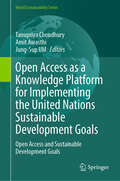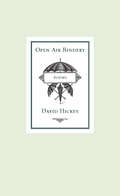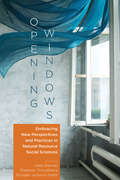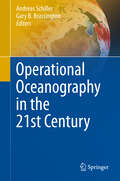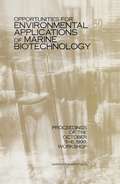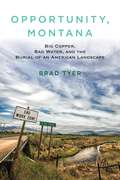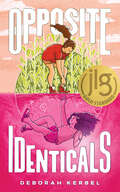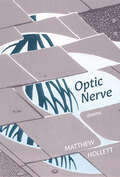- Table View
- List View
Only Kayak: A Journey Into The Heart Of Alaska
by Kim HeacoxWinner of the 2020 National Outdoor Book Award for Outdoor Classic!In this coming-of-middle-age memoir, Kim Heacox, writing in the tradition of Abbey, McPhee, and Thoreau, discovers an Alaska reborn from beneath a massive glacier, where flowers emerge from boulders, moose swim fjords, and bears cross crevasses with Homeric resolve. In such a place Heacox finds that people are reborn too, and their lives begin anew with incredible journeys, epiphanies, and successes. All in an America free of crass commercialism and overdevelopment.Braided through the larger story are tales of gold prospectors and the cabin they built sixty years ago; John Muir and his intrepid terrier, Stickeen; and a dynamic geology professor who teaches earth science "as if every day were a geological epoch."Nearly two million people come to Alaska every summer, some on large cruise ships, some in single kayaks--all in search of the last great wilderness, the Africa of America. It is exactly the America Heacox finds in this story of paradox, love, and loss.
Only Kayak: A Journey into the Heart of Alaska
by Kim HeacoxWinner of the 2020 National Outdoor Book Award for Outdoor Classic!In this coming-of-middle-age memoir, Kim Heacox, writing in the tradition of Abbey, McPhee, and Thoreau, discovers an Alaska reborn from beneath a massive glacier, where flowers emerge from boulders, moose swim fjords, and bears cross crevasses with Homeric resolve. In such a place Heacox finds that people are reborn too, and their lives begin anew with incredible journeys, epiphanies, and successes. All in an America free of crass commercialism and overdevelopment.Braided through the larger story are tales of gold prospectors and the cabin they built sixty years ago; John Muir and his intrepid terrier, Stickeen; and a dynamic geology professor who teaches earth science "as if every day were a geological epoch."Nearly two million people come to Alaska every summer, some on large cruise ships, some in single kayaks--all in search of the last great wilderness, the Africa of America. It is exactly the America Heacox finds in this story of paradox, love, and loss.
Only One
by Deborah HopkinsonThis lyrical, environmentally focused picture book showcases the unique beauty of our one and only universe--its galaxies, stars, and planets--as well as our one and only Earth and the precious life it contains. Join one girl as she leads her friends to a tree-planting ceremony. Along the way, she explains in simple language the value of the universe and Planet Earth. Readers will see the Big Bang, the Milky Way, all the planets in the solar system, as well as Earth's atmosphere, and the life within it: its oceans, trees, bugs, and seven billion human beings. Finally, the girl and her friends plant a tree--doing one small thing to help their one special planet. Both informative and inspiring, here is a beautifully written and gorgeously illustrated science picture book about our universe that will encourage young readers and listeners to protect and preserve the environment.
Only One Earth: Living for the Future
by Lloyd TimberlakeOriginally published in 1987, this book showcases global examples of people and communities who are learning to use the world’s resources without despoiling them for future generations. It includes chapters on nomadic life in Kenya, food supply in a Peruvian shantytown and a Buddhist monk in Sri Lanka who advises about tree planting and watersheds. Amidst climate change and environmental destruction this book looks at the world through the eyes of the people who tend it and finds hope in their growing understanding of their environment and in their willingness to live within the Earth’s resources.
Only One Earth: The Long Road via Rio to Sustainable Development
by Michael Strauss Felix Dodds with Maurice StrongForty years after the United Nations Conference on the Human Environment in Stockholm, the goal of sustainable development continues via the Rio+20 conference in 2012. This book will enable a broad readership to understand what has been achieved in the past forty years and what hasn’t. It shows the continuing threat of our present way of living to the planet. It looks to the challenges that we face twenty years from the United Nations Conference on Environment and Development, "The Earth Summit," in Rio, in particular in the areas of economics and governance and the role of stakeholders. It puts forward a set of recommendations that the international community must address now and in the the future. It reminds us of the planetary boundaries we must all live within and and what needs to be addressed in the next twenty years for democracy, equity and fairness to survive. Finally it proposes through the survival agenda a bare minimum of what needs to be done, arguing for a series of absolute minimum policy changes we need to move forward.
Onze Camino: Een gewoon echtpaar… Op een buitengewone wandeltocht. Een verslag van Scott en Jaynie Wall
by Jaynie Wall Scott WallEen inspirerende 800 kilometer lange wandeltocht door Spanje “Onze Camino de Santiago” is het verslag van een echtpaar dat begint bij hun mijmeringen over de 800 kilometer lange wandeltocht door Noord-Spanje en dat uiteindelijk eindigt met het voltooien van de tocht. Ondanks dat dit geen gedetailleerde gids is, geven Scott en Jaynie veel informatie die pelgrims op weg kunnen helpen. Lees “Onze Camino de Santiago” en laat je inspireren.
Oona (Oona #1)
by Kelly DiPucchioThis comical and heartfelt picture book is a winning celebration of invention, creativity, and friendship. With gorgeous underwater scenes and a crowd-pleasing tale, this is one little mermaid who is here to make a splash! New York Times bestselling author Kelly DiPucchio and Coretta Scott King Illustrator Award winner Raissa Figueroa would like to introduce Oona—the big wide sea’s littlest mischief-maker. Oona and her best friend Otto love to search for treasure…and often find trouble instead.Messy trouble.Tricky trouble.Even shark-related trouble.That’s never stopped them before, though!After all, no proper treasure hunt is without some adventure. But when the grandest treasure yet is stuck in a deep, dark rift, Oona’s not sure if she can dive right in. What might be waiting for her in those unknown waters?
Ooo Ooo Ooo Gorilla!
by Lydia MonksHooray! Gorilla has come to stay- he crashes through the door full of excitement and anticipation. And at first he's not disappointed. The family have thought of everything to make him comfortable. But then it begins to snow. . . and although Gorilla likes the look and taste of snow, he's not a natural at all the snow-related activities they try. With skiing and skating, he wibbles and wobbles all over the place before falling over. "Ooo, ooo, ooo," he cries. He doesn't like it. Even his snowman falls on top of him! So how can the little boy make him feel better? By finding something Gorilla is good at, that's how. And 'Ooo, ooo, ooo', it turns out to be something that's very exciting!
Ooo...Poo!
by Elliot KreloffJoin Rabbit and Fox on an informative, hilarious, and celebratory journey into the who, what, why, and where of poop."Children are fascinated by bodily functions, and this book endeavors to capture that need to know with a plethora of poo-related information [and] illustrations that will engage young readers wanting to know more." —School Library Journal Smelly, stinky, sandy poop. Litter poop. Whose poop? Kitty poop! Please scoop. Yes, we all poop—animals and humans, young and old, those who walk and fly and swim. And Ooo…Poo! is a joyful investigation into the who, what, why and where of poop on our planet Earth. The upbeat, rhythmic text encourages young readers to celebrate both their time spent on the potty and any scat they come across in the wild. Let&’s hear it for poo…woo hoo! MORE PRAISE FOR OOO...POO 'Cute, concise, and informative. It&’s the #1 &“Number 2&” book out there!' —Ethan Long, award-winning author and illustrator
Opal for 3rd Grade Student Edition Part Two (Mosdos Press Literature Series)
by Judith FactorAmasina was very pleased. The American doctors had decided to teach him how to carry out medical treatments used in the United States. They were also going to give him simple medical instruments and medications. He would be able to help the people of his tribe by giving injections, fluids, and antibiotics. Amasina would assist the doctors in return. He would share his knowledge about plants of the Amazon that he used to treat wounds and disease.
Open Access as a Knowledge Platform for Implementing the United Nations Sustainable Development Goals: Open Access and Sustainable Development Goals (World Sustainability Series)
by Jung-Sup Um Amit Awasthi Tanupriya ChoudhuryThis book incorporates the in-depth discussion on Open Access (OA) and Sustainable Development Goals (SDGs) set up by the United Nations and how OA expedites the progress toward the United Nations SDGs. Primary target audience are the scholars, policymakers, practitioners, and supporters, offering valuable insights into using OA to solve global problems. The book starts with basic understanding, explaining the basics of OA, how it connects to the SDGs, and showing examples of successful OA projects. The book highlights the role of open data in fostering innovation for sustainability, including specific instances where openly accessible datasets have stimulated innovation for sustainable development. The book looks at how OA lines up with specific SDGs like quality education, good health, infrastructure, etc. It also looks at the rules and plans needed to get more people using OA and predicts where OA is headed in the future for sustainable development. It also discusses the impact of open educational resources in democratizing learning globally, as well as the role of OA medical research in advancing health equity. The book also investigates how collaborative research platforms contribute to building green technology and bridging gender gaps in knowledge dissemination. Additionally, it discusses how free information exchange enables sustainable agriculture practices and how community-based participatory research archives empower local communities. Book also discusses the role of shared environmental studies and accessibility to legal and policy frameworks in promoting justice and climate action. Each chapter not only gives ideas but also offers practical instructions for using OA to share knowledge, work together across different fields, and make decisions based on facts that things are really important for reaching SDGs. Successful case studies are also presented to understand the benefits and drawback of OA especially by considering the SDGs. The book acknowledges the challenges of OA implementation.
Open Air Bindery
by David HickeyDavid Hickey's second collection builds upon the myriad strengths of his first. In a specimen book of songs, stories, and covenants, Hickey's subjects range from art and astronomy to snowflakes and suburbia. These poems "take their time / Covering the roadside trees in forms of their careful willing . . . gesturing down to earth, unveiling new shapes / for all that they find."David Hickey is a past recipient of the Milton Acorn Prize, the Ralph Gustafson Prize for Poetry, and was shortlisted for the Gerald Lampert Award for best first book of poetry in Canada. His work has appeared in magazines and journals across Canada and the United States.
Open Season: True Stories of the Maine Warden Service
by Daren WorcesterWoods Cop: True Stories of the Maine Warden Service is a collection of 21 stories from twoformer colonels, two lieutenants, two sergeants, four district wardens, a warden pilot, and onecurrently active duty corporal. Altogether, their cumulative experiences account for more than300 years of warden experience.Before reality TV cameras, GPS devices, and dashboard computers, these wardenspresided over a coming of age era for the Maine Warden Service. It was a time when a compass,map, and their wits were what mattered most in the field. Every day offered the potential for anexciting new adventure, many of which endangered the wardens themselves.This book recreates the full warden experience. In addition to hair-raising, life-and-deathscenarios, the collection covers moments such as a child innocently outing his parents as&“looking for deer&” at night, the doldrums of a stakeout, and the grief of tragedy. The stories havebeen written in a third person, narrative format to ensure consistency in style and to help readersfeel the excitement of a twig snapped in the dark, the frustration of second guessing yourselfwhen lives are at stake, and the duty to do what&’s right, even if it means breaking the law.
Open Water Swimming Manual: An Expert's Survival Guide for Triathletes and Open Water Swimmers
by Lynne CoxLynne Cox has set open water swimming records across the world, and now she has focused her decades-long experience and expertise into this definitive guide to swimming. Cox methodically addresses what is needed to succeed at and enjoy open water swimming, including choosing the right bathing suit and sunscreen; surviving in dangerous weather conditions, currents, and waves; confronting various marine organisms; treating ailments, such as being stung or bitten, and much more. Cox calls upon Navy SEAL training materials and instructors' knowledge of open water swimming and safety procedures to guide her research. In addition, first-hand anecdotes from SEAL specialists and stories of Cox's own experiences serve as both warnings and proper practices to adopt. Open Water Swimming Manual provides a wealth of knowledge for all swimmers, from seasoned triathletes and expert swimmers to beginners exploring open water swimming for the first time. It is, as well, the first manual of its kind to make use of oceanography, marine biology, and to weave in stories about the successes and failures of other athletes, giving us a deeper, broader understanding of this exhilarating and fast growing sport.From the Trade Paperback edition.
Open for Business: Conservatives' Opposition to Environmental Regulation
by Judith A. LayzerSince the 1970s, conservative activists have invoked free markets and distrust of the federal government as part of a concerted effort to roll back environmental regulations. They have promoted a powerful antiregulatory storyline to counter environmentalists' scenario of a fragile earth in need of protection, mobilized grassroots opposition, and mounted creative legal challenges to environmental laws. But what has been the impact of all this activity on policy? In this book, Judith Layzer offers a detailed and systematic analysis of conservatives' prolonged campaign to dismantle the federal regulatory framework for environmental protection. Examining conservatives' influence from the Nixon era to the Obama administration, Layzer describes a set of increasingly sophisticated tactics--including the depiction of environmentalists as extremist elitists, a growing reliance on right-wing think tanks and media outlets, the cultivation of sympathetic litigators and judges, and the use of environmentally friendly language to describe potentially harmful activities. She argues that although conservatives have failed to repeal or revamp any of the nation's environmental statutes, they have influenced the implementation of those laws in ways that increase the risks we face, prevented or delayed action on newly recognized problems, and altered the way Americans think about environmental problems and their solutions. Layzer's analysis sheds light not only on the politics of environmental protection but also, more generally, on the interaction between ideas and institutions in the development of policy.
Open the Dark: Poems
by Marie Tozier“Tozier’s first book of poems clearly is emplaced in family, community, geography, history, and the seasonality of animals and plants in Western Alaska.” —Elizabeth Bradfield, author ofToward AntarcticaOpen the Dark is an exquisite collection of poems depicting a generational tapestry woven with the shared ebb and flow of land and sea and time. Loving hands, dyed sweet with raspberries and lingonberries, pass ancestral knowledge—of the hunt for seal and crab to pressing ironless, ruler-straight seams—from grandmother to mother, mother to daughter. This is a collection that beckons, like a mother’s warm embrace, into the vibrant scent and taste of Iñupiaq Alaska.“A lyrical guide to the life in Northwest Alaska experienced by the Iñupiaq poet and her family . . . Like most books of good poems, it is also a gallery of images for revisiting time after time.” —49 Writers“These deceptively simple poems enlarge with repeated readings; they unfold greater meaning each time and leave a reader with much to contemplate about identity, cultures, generational wisdom, and values. Marie Tozier’s fresh voice is a very welcome addition to Alaskan, Indigenous and American literature.” —Anchorage Daily News
Opening Windows: Embracing New Perspectives and Practices in Natural Resource Social Sciences (Society and Natural Resources Book Series)
by Daniel R. Williams Christine Knott Rachel Kelly Grace Wang William Stewart Anna Haines John Schelhas Yan Chen Robert Emmet Jones E. Carina H. Keskitalo Sarah Hitchner John R. Parkins Robert Berry Paul Hebinck Andrea Rawluk Simon West Douglas Jackson-Smith Jaye Mejía-Duwan Michaela Hoffelmeyer Angie Carter Gabrielle Roesch-McNally Jasmine K. Brown Michael Dockry Sarah Naiman Evan J. Andrews Solange Nadeau Courtenay Parlee Archi Rastogi Maria Andrée Lópex Gómez Madu Galappaththi Ana Carolina Esteves Dias Richard Dimba Kiaka Rodgers Lubilo Prativa Sapkota Rebecca M. Ford Maddison Miller Kathryn J. H. Williams Christopher Jadallah Eliza Oldach Abraham Miller-Rushing Caitlin Hafferty Ian Babelon Beth Brockett James Hoggett Bryanne Lamoureux Melanie Zurba Durdana Islam Kate Sherren Tobin N. Walton Wiebren Johannes Boonstra Sasha Quahe Jessica Cockburn Nosiseko Mtati Vanessa Masterson Gladman Thondhlana Brett Alan Miller Polly NguyenThe third decennial review from the International Association for Society and Natural Resources, Opening Windowssimultaneously examines the breadth and societal relevance of Society and Natural Resources (SNR) knowledge, explores emergent issues and new directions in SNR scholarship, and captures the increasing diversity of SNR research. Authors from various backgrounds—career stage, gender and sexuality, race/ethnicity, and global region—provide a fresh, nuanced, and critical look at the field from both researchers’ and practitioners’ perspectives. This reflexive book is organized around four key themes: diversity and justice, governance and power, engagement and elicitation, and relationships and place. This is not a complacent volume—chapters point to gaps in conventional scholarship and to how much work remains to be done. Power is a central focus, including the role of cultural and economic power in “participatory” approaches to natural resource management and the biases encoded into the very concepts that guide scholarly and practical work. The chapters include robust literature syntheses, conceptual models, and case studies that provide examples of best practices and recommend research directions to improve and transform natural resource social sciences. An unmistakable spirit of hope is exemplified by findings suggesting positive roles for research in the progress ahead. Bringing fresh perspectives on the assumptions and interests that underlie and entangle scholarship on natural resource decisionmaking and the justness of its outcomes, Opening Windows is significant for scholars, students, natural resource practitioners, managers and decision makers, and policy makers.
Operation Bite Back: Rod Coronado's War to Save American Wilderness
by Dean KuipersAs the environmental movement gains followers and momentum, Kuipers presents an insider's look at its radical wing and its uneasy relationship with the mainstream.
Operational Oceanography in the 21st Century
by Andreas Schiller Gary B. BrassingtonOver the past decade the significant advances in real-time ocean observing systems, ocean modelling, ocean data assimilation and super-computing has seen the development and implementation of operational ocean forecast systems of the global ocean. At the conclusion of the Global Ocean Data Assimilation Experiment (GODAE) in 2008 ocean analysis and forecasting services were being supported by 12 international centres. This book is about ocean forecasting - a maturing field which remains an active area of research, and includes such topics as ocean predictability, observing system design, high resolution ocean modelling and ocean data assimilation. It presents the introduction to ocean forecasting which provides a foundation for new opportunities in areas of coupled bio-geochemical forecasting and coupled atmosphere-wave-ocean forecasting. The book describes an updated account of research and development to improve forecast systems, determining how best to service the marine user community with forecast information as well as demonstrating impact to their applications. It also discusses operational centres that are now supporting a range of real-time ocean services including online graphical and data products for their user communities and their feedback on the quality of information. The contents of this book are aimed at early career scientists and professionals with an interest in operational oceanography and related ocean science. There are excellent opportunities for exciting careers in the emerging field of operational oceanography in order to address current and future challenges as well as provide the supporting services to a rapidly growing user community.
Opossum (Nature's Children)
by Laima DingwallHow is the opossum related to the Tasmanian Devil? Is an opossum bigger or smaller than a house cat? What happens when an opossum "plays dead"? Find the answers to these questions, and learn much more about the physical characteristics, behavior, habitat, and lives of opossums.
Opportunities For Environmental Applications Of Marine Biotechnology: Proceedings Of The October 5-6, 1999, Workshop
by Board On BiologyInformation on the Opportunities For Environmental Applications Of Marine Biotechnology
Opportunities to Use Remote Sensing in Understanding Permafrost and Related Ecological Characteristics: Report of a Workshop
by Committee on Opportunities to Use Remote Sensing in Understanding Permafrost Ecosystems: A WorkshopPermafrost is a thermal condition -- its formation, persistence and disappearance are highly dependent on climate. General circulation models predict that, for a doubling of atmospheric concentrations of carbon dioxide, mean annual air temperatures may rise up to several degrees over much of the Arctic. In the discontinuous permafrost region, where ground temperatures are within 1-2 degrees of thawing, permafrost will likely ultimately disappear as a result of ground thermal changes associated with global climate warming. Where ground ice contents are high, permafrost degradation will have associated physical impacts. Permafrost thaw stands to have wide-ranging impacts, such as the draining and drying of the tundra, erosion of riverbanks and coastline, and destabilization of infrastructure (roads, airports, buildings, etc. ), and including potential implications for ecosystems and the carbon cycle in the high latitudes. "Opportunities to Use Remote Sensing in Understanding Permafrost and Related Ecological Characteristics" is the summary of a workshop convened by the National Research Council to explore opportunities for using remote sensing to advance our understanding of permafrost status and trends and the impacts of permafrost change, especially on ecosystems and the carbon cycle in the high latitudes. The workshop brought together experts from the remote sensing community with permafrost and ecosystem scientists. The workshop discussions articulated gaps in current understanding and potential opportunities to harness remote sensing techniques to better understand permafrost, permafrost change, and implications for ecosystems in permafrost areas. This report addresses questions such as how remote sensing might be used in innovative ways, how it might enhance our ability to document long-term trends, and whether it is possible to integrate remote sensing products with the ground-based observations and assimilate them into advanced Arctic system models. Additionally, the report considers the expectations of the quality and spatial and temporal resolution possible through such approaches, and the prototype sensors that are available that could be used for detailed ground calibration of permafrost/high latitude carbon cycle studies.
Opportunity, Montana: Big Copper, Bad Water, and the Burial of an American Landscape
by Brad TyerA memoir-meets-exposé that examines our fraught relationship with the West and our attempts to clean up a toxic environmental legacy In 2002, Texas journalist Brad Tyer strapped a canoe on his truck and moved to Montana, a state that has long exerted a mythic pull on America's imagination as an unspoiled landscape. The son of an engineer who reclaimed wastewater, Tyer was looking for a pristine river to call his own. What he found instead was a century's worth of industrial poison clotting the Clark Fork River, a decades-long engineering project to clean it up, and a forgotten town named Opportunity. At the turn of the nineteenth century, Montana exploited the richest copper deposits in the world, fueling the electric growth of twentieth-century America and building some of the nation's most outlandish fortunes. The toxic by-product of those fortunes--what didn't spill into the river--was dumped in Opportunity. In the twenty-first century, Montana's draw is no longer metal but landscape: the blue-ribbon trout streams and unspoiled wilderness of the nation's "last best place." To match reality to the myth, affluent exurbanites and well-meaning environmentalists are trying to restore the Clark Fork River to its "natural state." In the process, millions of tons of toxic soils are being removed and dumped--once again--in Opportunity. As Tyer investigates Opportunity's history, he wrestles with questions of environmental justice and the ethics of burdening one community with an entire region's waste. Stalled at the intersection of a fading extractive economy and a fledgling restoration boom, Opportunity's story is a secret history of the American Dream and a key to understanding the country's--and increasingly the globe's--demand for modern convenience. As Tyer explores the degradations of the landscape, he also probes the parallel emotional geography of familial estrangement. Part personal history and part reportorial narrative, Opportunity, Montana is a story of progress and its price: of copper and water, of father and son, and of our attempts to redeem the mistakes of the past. From the Hardcover edition.
Opposite Identicals: A Novel
by Deborah KerbelA Junior Library Guild Pick!Opposite Identicals is an upper middle grade novel set in the very near future – a time when climate change has irreversibly altered our planet and lifestyles. Nova and Joule are fourteen-year old twins whose scientist parents have recently uprooted the family from their urban home and moved to the country on a year–long research assignment, studying the effects of GMO 'SuperCrop' farming on the environment in the final regulatory phase before global expansion. Surrounded by nature and quiet, open spaces, shy, bookish Nova is in heaven. But Joule – whose life' s ambition is to be famous and reach a million Hollagram followers – is desperate to escape. One day, Joule gets her wish, although not in a way anyone ever expected. In an instant, she's gone – swallowed up by a mysterious sinkhole under her bedroom floor. Suddenly twinless, Nova is forced to step in and lead the search for her missing sister. But can she face her fears and figure out what caused the sinkhole in time to save Joule?
Optic Nerve
by Matthew HollettShortlisted 2024 JM Abraham Award for PoetryPoems using fervent whimsy and wordplay to examine photography and seeing. Peering inside eyeballs, pondering the paradox of absent stars, and meditating on street scenes by André Kertész, these poems squint sidelong at our ways of seeing the world. Through playful poems about photography and visual perception, Hollett dissects auroras and quarks, atmospheric phenomena, potatoes, bomb craters and peat bog cadavers. This darkly comic collection is shadowed by entoptic paparazzi, haunted by peripheral visions. Born of attentive walking and looking, of footsteps and snapshots, it bears witness to art history and alluvial light, portable keyholes, the pandemic, climate change, and the sheer strangeness of seeing everyday things with ecstatic eyes.
